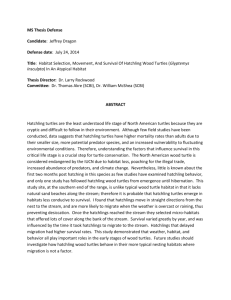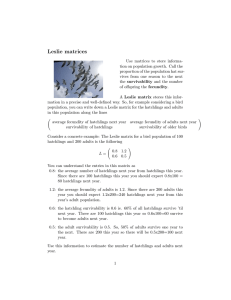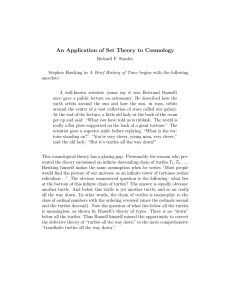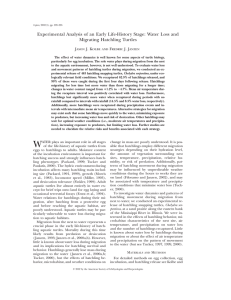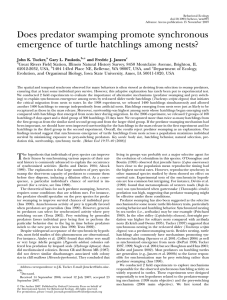Experimental analysis of an early life-history stage: avian predation
advertisement
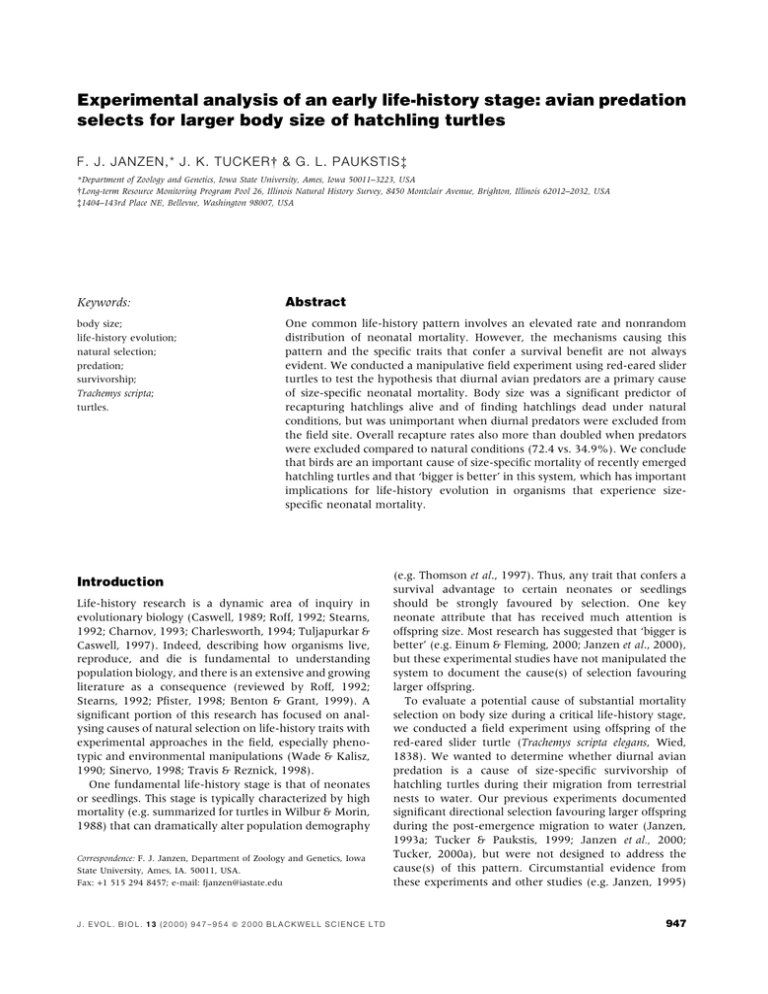
Experimental analysis of an early life-history stage: avian predation selects for larger body size of hatchling turtles F. J. JANZEN,* J. K. TUCKER & G. L. PAUKSTISà *Department of Zoology and Genetics, Iowa State University, Ames, Iowa 50011±3223, USA Long-term Resource Monitoring Program Pool 26, Illinois Natural History Survey, 8450 Montclair Avenue, Brighton, Illinois 62012±2032, USA à1404±143rd Place NE, Bellevue, Washington 98007, USA Keywords: Abstract body size; life-history evolution; natural selection; predation; survivorship; Trachemys scripta; turtles. One common life-history pattern involves an elevated rate and nonrandom distribution of neonatal mortality. However, the mechanisms causing this pattern and the speci®c traits that confer a survival bene®t are not always evident. We conducted a manipulative ®eld experiment using red-eared slider turtles to test the hypothesis that diurnal avian predators are a primary cause of size-speci®c neonatal mortality. Body size was a signi®cant predictor of recapturing hatchlings alive and of ®nding hatchlings dead under natural conditions, but was unimportant when diurnal predators were excluded from the ®eld site. Overall recapture rates also more than doubled when predators were excluded compared to natural conditions (72.4 vs. 34.9%). We conclude that birds are an important cause of size-speci®c mortality of recently emerged hatchling turtles and that `bigger is better' in this system, which has important implications for life-history evolution in organisms that experience sizespeci®c neonatal mortality. Introduction Life-history research is a dynamic area of inquiry in evolutionary biology (Caswell, 1989; Roff, 1992; Stearns, 1992; Charnov, 1993; Charlesworth, 1994; Tuljapurkar & Caswell, 1997). Indeed, describing how organisms live, reproduce, and die is fundamental to understanding population biology, and there is an extensive and growing literature as a consequence (reviewed by Roff, 1992; Stearns, 1992; P®ster, 1998; Benton & Grant, 1999). A signi®cant portion of this research has focused on analysing causes of natural selection on life-history traits with experimental approaches in the ®eld, especially phenotypic and environmental manipulations (Wade & Kalisz, 1990; Sinervo, 1998; Travis & Reznick, 1998). One fundamental life-history stage is that of neonates or seedlings. This stage is typically characterized by high mortality (e.g. summarized for turtles in Wilbur & Morin, 1988) that can dramatically alter population demography Correspondence: F. J. Janzen, Department of Zoology and Genetics, Iowa State University, Ames, IA. 50011, USA. Fax: +1 515 294 8457; e-mail: fjanzen@iastate.edu J. EVOL. BIOL. 13 (2000) 947±954 ã 2000 BLACKWELL SCIENCE LTD (e.g. Thomson et al., 1997). Thus, any trait that confers a survival advantage to certain neonates or seedlings should be strongly favoured by selection. One key neonate attribute that has received much attention is offspring size. Most research has suggested that `bigger is better' (e.g. Einum & Fleming, 2000; Janzen et al., 2000), but these experimental studies have not manipulated the system to document the cause(s) of selection favouring larger offspring. To evaluate a potential cause of substantial mortality selection on body size during a critical life-history stage, we conducted a ®eld experiment using offspring of the red-eared slider turtle (Trachemys scripta elegans, Wied, 1838). We wanted to determine whether diurnal avian predation is a cause of size-speci®c survivorship of hatchling turtles during their migration from terrestrial nests to water. Our previous experiments documented signi®cant directional selection favouring larger offspring during the post-emergence migration to water (Janzen, 1993a; Tucker & Paukstis, 1999; Janzen et al., 2000; Tucker, 2000a), but were not designed to address the cause(s) of this pattern. Circumstantial evidence from these experiments and other studies (e.g. Janzen, 1995) 947 948 F. J. JANZEN ET AL. suggests that predation is the likely mechanism behind the observed size-speci®c mortality or recapture probabilities. Thus, using hatchling turtles produced from eggs incubated in a common-garden environment, we tested the predation hypothesis by leaving the ®eld site unmanipulated during one experimental release of hatchling turtles and by excluding birds from the ®eld site during a subsequent experimental release. Materials and methods Experimental methods Organism Adult red-eared slider turtles (T. s. elegans) at the study site in the Mississippi River State Fish and Wildlife Refuge, Jersey County, Illinois, nest from mid-May to early July, averaging ~14 eggs per clutch (Tucker et al., 1998). Eggs average ~11 g and hatchling size is strongly dependent on egg size (Tucker et al., 1998; Janzen et al., 2000). Neonates hibernate in the nest before emerging to migrate to aquatic habitats between mid-April and early June the following spring (Tucker, 1997, 2000b). Collection and incubation of eggs In May and June 1996, 277 turtles were captured on their nesting migrations at or near the ®eld site. These females were induced to oviposit with an injection of oxytocin (Ewert & Legler, 1978). Eggs were tamped dry, numbered uniquely, weighed to the nearest 0.01 g, and incubated on moist vermiculite (±150 kPa) in covered, plastic shoeboxes. Shoeboxes were rehydrated approximately once weekly to maintain the initial level of substrate moisture and then were rotated within the incubation room to minimize the potential in¯uence of thermal gradients on hatchling phenotypes. Incubation temperatures ¯uctuated as they do in natural nests (e.g. Weisrock & Janzen, 1999), averaging 27 °C with daily variation of 16±35 °C (see Tucker & Warner, 1999). Because all eggs were exposed to a similar thermal environment, this commongarden experimental design thereby eliminated the possible impact of phenotypic variation due to among-nest variation in substrate moisture and incubation temperature (reviewed by Packard, 1991). Hatchlings Upon hatching, turtles were weighed to the nearest 0.01 g and carapace length was measured to the nearest 0.1 mm with vernier calipers. Hatchlings were kept in plastic boxes with moist vermiculite (±150 kPa) placed in a darkened room for hibernation, which was unheated except when necessary to prevent freezing (mean 6.7 °C) (Tucker & Paukstis, 1999). This ¯uctuating thermal regime mimicked that observed in natural nests at the ®eld site (Tucker & Packard, 1998). After hibernating until 6 May 1997, we divided hatchlings from 221 clutches into two groups of 525 turtles for this study. All 1050 hatchlings were reweighed and remeasured on 11±12 May and kept in a cool, dark room until the experimental releases. Field methods Drift fence We constructed a 260 m long drift fence with 17 pitfall traps from 0.3 m high aluminium ¯ashing down slope from the known nesting area (Tucker, 1997, 2000b). Prior to the experimental releases, tall vegetation in direct contact with the aluminium ¯ashing was removed to prevent hatchlings from climbing over the fence. Hatchlings that emerged from natural nests at the ®eld site were caught in the drift fence between 30 April and 5 June (95 `natural' hatchlings) (see Tucker, 2000b), indicating that the timing of the two experimental releases described below was ecologically relevant. Control treatment Hatchlings were released at 0600 CDT on 14 May following methods used in previous experiments (Tucker & Paukstis, 1999; Janzen et al., 2000; Tucker, 2000a). The release point was 40 m up slope from the drift fence, centred perpendicularly to pit 9 on the drift fence. The drift fence was monitored twice daily at 0600 and 1800 CDT through 19 May. Potential diurnal-avian predators were noted, primarily red-winged blackbirds (Agelaius phoeniceus, Linnaeus, 1766) and common grackles (Quiscalus quiscula, Linnaeus, 1758). Recaptured hatchlings were identi®ed from photocopies of the plastron taken prior to the releases and weighed to the nearest 0.01 g. Searches for dead hatchlings were conducted intermittently when predator disturbance was desired (see below). Predator-exclusion treatment Hatchlings were released at 0600 CDT on 20 May in the same location and manner as the turtles in the control treatment. Once the hatchlings were released, an investigator was present continuously during daylight hours until 24 May to actively exclude potential avian predators. Because some birds were persistent and would attempt to land in the release area despite our presence, we used rocks and a slingshot to frighten away birds. This method permitted us to exclude birds without entering the release area and interfering with the turtles. No birds were struck by projectiles. The drift fence was monitored every 30 min on 20 and 21 May and hourly on 22 and 23 May. Recaptured hatchlings were processed as in the control treatment. We entered the release area on 23 May, and again between 29 May and 6 June, to conduct extensive searches for dead hatchlings from both treatments. Statistical analyses Hatchlings fell into one of the three categories at the termination of the treatments: (1) recaptured alive J. EVOL. BIOL. 13 (2000) 947±954 ã 2000 BLACKWELL SCIENCE LTD Avian predation on hatchling turtles (2) found dead, or (3) fate unknown. We employed hatchling mass at release as a measure of body size for all within- and between-treatment statistical analyses among the three recapture classi®cations. Results using carapace length instead of body mass as a measure of hatchling size were similar and therefore are not presented. Unless stated otherwise, statistical analyses were conducted using SAS (SAS Institute, 1988). Between-treatment analyses We compared recapture frequencies between the treatments using G-tests (Sokal & Rohlf, 1981). We also used Kruskal±Wallis tests to compare mass at release between the same hatchling recapture categories for the two treatments. Within-treatment analyses Previous research showed that smaller hatchlings vanish disproportionately during the post-emergence migration (Janzen, 1993a; Tucker & Paukstis, 1999; Janzen, et al., 2000; Tucker, 2000a), thus we began each treatment with certain a priori expectations. For the control treatment where methods caused minimal disturbance of diurnal predators, we expected that hatchlings recaptured alive would be larger than (1) all neonates not recaptured (i.e. all hatchlings found dead or of unknown fate) and (2) just hatchlings found dead. We evaluated these two hypotheses using one-tailed Kruskal±Wallis tests. For the predator exclusion treatment where methods resulted in maximal disturbance of diurnal predators, we expected that hatchlings recaptured alive (1) would be neither larger nor smaller than all turtles not recaptured and (2) would be larger than those found dead, assuming that the dead hatchlings were killed by predators despite our efforts. We evaluated the ®rst hypothesis with a two-tailed Kruskal±Wallis test and the second with a one-tailed Kruskal±Wallis test. We also used random-effects logistic regression (Stiratelli et al., 1984) implemented in a Fortran programme (Janzen et al., 2000; H. Stern and A. H. Jones, personal communication) to determine whether hatchling mass predicted the likelihood of recapturing hatchlings alive (i.e. recaptured alive vs. found dead or of unknown fate). Table 1 Descriptive statistics for 1050 hatchling T. s. elegans released in two treatments. Variable Release mass (g) Recapture mass (g) Change in mass (g) Recapture time (d) Recapture time-actual (d) Recapture location (pit) Min. distance to pit (m) 949 This algorithm permitted us to account for maternal identity properly as a random effect in the regression analyses while we focused on our primary variable of interest, hatchling mass. To aid in visualizing the form of selection on hatchling mass in greater detail, we used the cubic-spline technique, a nonparametrical regression method (Schluter, 1988; Janzen, 1993a; Brodie et al., 1995; Janzen et al., 2000). We calculated standard errors for each spline function by bootstrapping the data 100 times. Results Between-treatment analyses Hatchling morphology and behaviour were similar in the two treatments. Mass at release did not differ signi®cantly between the two treatments (KW 0.82, d.f. 1, P 0.3650) nor did change in mass of hatchlings during their migration to the drift fence (KW 1.83, d.f. 1, P 0.1761) (Table 1). Overall, hatchlings in the two treatments followed similar paths and took about the same amount of time to reach the drift fence (Table 1). The two treatments differed extensively, however, in the number of hatchlings either recaptured, not found, or found dead (G 188.05, d.f. 2, P < 0.0001). Of particular relevance, signi®cantly more hatchlings were (1) recaptured alive in the predator-exclusion treatment (G 46.29, d.f. 1, P < 0.0001) and (2) found dead in the control treatment (G 70.12, d.f. 1, P < 0.0001) (Table 2). Body mass at release for the different survival categories of hatchlings also differed between the two treatments. Hatchlings recaptured in the control treatment were signi®cantly heavier than those recaptured in the predator-exclusion treatment (Table 2; KW 2.91, d.f. 1, one-tailed P 0.0438), suggesting that exclusion of diurnal predators resulted in relatively more small hatchlings surviving to reach the drift fence. Hatchlings of unknown fate were lighter in the control treatment than in the predator exclusion treatment (Table 2; KW 4.82, d.f. 1, one-tailed P 0.0141), implying that more small hatchlings survived to reach the fence, Control Mean (SD), Range Predator exclusion Mean (SD), Range 6.43 6.37 0.24 1.04 6.50 6.16 0.30 0.82 0.50 9.56 64.5 (1.01), (1.02), (0.41), (1.04), 3.35±8.86 3.71±8.80 )0.49±2.29 0.5±7.5 9.93 (3.47), 1±17 70.4 (27.9), 40.0±151.6 (0.98), (1.13), (0.46), (0.78), (0.82), (3.22), (28.6), 3.98±9.43 3.40±8.83 )0.74±1.98 0.5±6.5 0.04±6.5 1±17 40.0±151.6 *n 525 for release mass for each treatment; for the remaining variables, n 183 for the control treatment and n 380 for the predator-exclusion treatment. J. EVOL. BIOL. 13 (2000) 947±954 ã 2000 BLACKWELL SCIENCE LTD 950 F. J. JANZEN ET AL. Control Predator exclusion Status n Mean (SD), Range n Mean (SD), Range Recaptured Not found Found dead 183 278 64 6.62 (0.99), 4.11±8.86 6.37 (1.00), 3.35±8.48 6.20 (1.10), 3.75±8.81 380 143 2 6.46 (1.00), 3.98±9.43 6.62 (0.95), 4.16±8.95 6.29 (0.76), 5.75±6.83 and thus fewer of them were among the hatchlings that were not recovered, compared with the control treatment. Finally, hatchlings found dead in both treatments were similar in mass at release (Table 2; KW 0.02, d.f. 1, P 0.8811). These results are re¯ected in the cubic-spline analyses, which illustrate linear selection across the whole range of body mass in the control treatment and essentially no selection when predators were excluded (Fig. 1). Table 2 Descriptive statistics for mass at release for three survival categories of hatchling T. s. elegans released in two treatments. Within-treatment analyses Control treatment We found 183 (34.9%) hatchlings alive and 64 (12.2%) dead, with the remaining 278 (53.0%) turtles having an unknown fate. We recaptured the ®rst hatchlings at the drift fence at 1800 CDT on 14 May (i.e. 12 h after release). The drift fence was monitored through 6 June, but the last individual from this treatment recaptured alive was found at 1800 CDT on 21 May. Live hatchlings in this control treatment were caught in every pit along the drift fence, with the most being recaptured in pits near the central portion of the fence (Table 1; skewness ±0.39, kurtosis ±0.12, mean pit 9.93, SD 3.47 pits). Body mass of hatchling turtles at the time of release varied systematically with the date of recapture at the drift fence. Heavier hatchlings tended to be recaptured sooner than lighter individuals (KW 21.56, d.f. 8, P 0.0058), particularly in the ®rst 3 days of the treatment when most turtles were recovered. Consistent with these results, elapsed time from release to recapture was negatively correlated with mass at release (r ± 0.27, P 0.0003). Body mass of hatchling turtles at the time of release also differed signi®cantly among the three categories of recapture status (Table 2; KW 9.47, d.f. 2, P 0.0088). Hatchlings recaptured alive were heavier at the time of release than those not recaptured alive (KW 7.98, d.f. 1, one-tailed P 0.0024) and heavier than those just found dead (KW 6.89, d.f. 1, onetailed P 0.0044). These results were supported by logistical-regression analysis, which found that mass of hatchlings at the time of release signi®cantly predicted the probability of recapturing them alive (v2 8.85, d.f. 1, P 0.0029). Larger hatchlings were more likely to be recaptured alive than were smaller ones (Fig. 1). Predator-exclusion treatment Fig. 1 Probability of survival of hatchling T. s. elegans in relation to body mass during the control treatment (top panel) and the predator-exclusion treatment (bottom panel). Hatchlings not recaptured were considered dead for these analyses. The surfaces were derived using a cubic-spline algorithm and indicate (1) selection favouring larger hatchlings in the control treatment and (2) essentially no selection on hatchling size in the predator-exclusion treatment. The SE lines ¯anking the selection surfaces were generated by bootstrapping the data 100 times. In contrast to the control treatment, we recaptured alive more than double the number of experimental hatchlings (380 or 72.4%) and found only 2 (0.4%) dead, with 143 (27.2%) of the hatchlings unaccounted for. We recaptured live hatchlings at the drift fence in this treatment beginning at 0700 CDT on 20 May and ending at 1800 CDT on 26 May (again, the drift fence was monitored through 6 June). As in the control treatment, live hatchlings were caught in every pit along the fence, J. EVOL. BIOL. 13 (2000) 947±954 ã 2000 BLACKWELL SCIENCE LTD Avian predation on hatchling turtles centring around the middle (Table 1; skewness ±0.11, kurtosis 0.39, mean pit 9.56, SD 3.22 pits). Mass of hatchlings at release did not vary signi®cantly with date of recapture (KW 13.89, d.f. 8, P 0.0848). Even so, elapsed time from release to recapture (to the nearest half day) was negatively correlated with hatchling mass at the time of release (r ± 0.16, P 0.0013), suggesting that heavier hatchlings were in fact reaching the drift fence faster than lighter turtles. Focusing only on the ®rst day of the predator-exclusion treatment, when 317 hatchlings were recaptured alive and the recapture time was known to the nearest half hour, produced a similar result (KW 27.50, d.f. 19, P 0.0935 and r ±0.19, P 0.0009). Body mass of hatchlings at the time of release did not vary signi®cantly among the three categories of recapture status (Table 2; KW 2.38, d.f. 2, P 0.3048). Hatchlings recaptured alive were similar in mass at the time of release to those not recaptured (KW 2.09, d.f. 1, two-tailed P 0.1486) and to only those found dead (KW 0.10, d.f. 1, one-tailed P 0.3753). Results from the logistical regression analysis con®rmed the overall impression that mass of hatchlings at the time of release in this treatment was not a signi®cant predictor of the probability of recapturing those individuals alive (v2 2.48, d.f. 1, P 0.1154). Larger hatchlings were just as likely to be recaptured alive as were smaller ones when diurnal predators were excluded from the experimental area (Fig. 1). Discussion Mechanism behind patterns of offspring mortality The results of this manipulative experimental study document on avian predation as a primary cause of size-dependent mortality of hatchling turtles between the time they emerge from the nest until the time they reach their future aquatic home. Larger neonates in the control treatment were more likely to be recaptured alive and less likely to be found dead than were smaller individuals (Fig. 1, Table 2). This ®nding is consistent with the results of previous experiments involving this population of red-eared sliders (Tucker & Paukstis, 1999; Janzen et al., 2000; Tucker, 2000a) and painted turtles (Chrysemys picta, Schneider, 1783) (Tucker, 2000a), and a different population of common snapping turtles (Chelydra serpentina, Linnaeus, 1758) (Janzen, 1993a). In contrast, when birds were excluded from the ®eld site, the probability of recapturing hatchlings alive more than doubled and was independent of body size (Fig. 1, Table 2). Birds have long been suspected of size-dependent predation on hatchlings of a wide variety of turtles (reviewed in Janzen et al., 2000); our study suggests that this is true. The conclusion that avian predation caused the different recapture patterns is supported by an additional J. EVOL. BIOL. 13 (2000) 947±954 ã 2000 BLACKWELL SCIENCE LTD 951 result. In the predator-exclusion treatment, the percentage of turtles of unknown fate was smaller than in the control treatment and the percentage of turtles recaptured alive was larger (Table 2). This ®nding suggests that many of the hatchlings whose fate cannot be determined with certainty in the control treatment and in previous experiments were probably killed by birds. The uncertainty of their fate is presumably due to transport by predators out of the area, complete ingestion by predators, or our inability to ®nd their carcasses in the ®eld. We were unable to perform replicates because the large scale of the study made them unfeasible and environmental conditions changed substantially as summer progressed. This was even true to some extent between the two treatments that we did execute. However, the results of the control treatment were similar to those from comparable studies conducted at the site in other years (Tucker & Paukstis, 1999; Janzen et al., 2000; Tucker, 2000a). Did we attract an unnaturally large number of predators to the area by releasing so many turtles simultaneously? Two lines of evidence suggest that we did not. First, we collected a number of hatchlings that emerged from natural nests, and have captured as many as 60 such `natural' turtles in a single day (Tucker, 1997), which is about half the number recaptured in one day during the control treatment. Furthermore, the survival and mortality probabilities from the control treatment were nearly identical to those obtained in an earlier experiment where fewer turtles were released simultaneously (178) and recaptured in one day (31) (Janzen et al., 2000). We also collected hundreds of females during their nesting forays to obtain eggs for this experiment. Had these females been permitted to nest, even with nest predation the area would have been ®lled with numerous hatchlings in late spring when our experiment was conducted. The other important evidence in favour of the ecological relevance of our design derives from an experiment in which equal numbers of turtles (1) were released simultaneously as in prior studies and (2) were placed in nest cavities to emerge and migrate at their leisure (F. Janzen, J. Tucker & G. Paukstis, unpublished work). For both sets of hatchlings, larger individuals were recaptured alive signi®cantly more often than smaller turtles. We are left with the conclusion that birds killed smaller hatchlings signi®cantly more often than larger individuals. The primary avian predators observed in the area were red-winged blackbirds (A. phoeniceus) and common grackles (Q. quiscula). These birds could conceivably have gape limitations in the size range of hatchling T. scripta, a mechanism that has been invoked by other researchers (e.g. Swingland & Coe, 1979). Still, these two species readily attack and kill young turtles (e.g. Janzen, 1995). A more likely explanation is that larger neonates are faster than smaller ones (Miller et al., 1987; Janzen, 1993b; Miller, 1993). Consequently, smaller hatchlings 952 F. J. JANZEN ET AL. spent more time migrating and, thus, may have been exposed to predators for a greater period than were larger turtles. This scenario implies that predators exert selection favouring larger hatchlings simply because they encounter smaller turtles more frequently. Future experiments are required to test this hypothesis. Although avian predation was most likely the mechanism behind the differences between the two treatments reported here, other factors could affect survivorship of hatchling turtles. Low energy reserves seem unlikely to be important because neonates of aquatic turtles appear to have ample quantities of residual yolk or fat bodies to sustain them until they reach an aquatic habitat (reviewed in Packard & Packard, 1988; Vleck & Hoyt, 1991). Desiccation is more likely to exert a signi®cant impact on hatchling mortality during this period, because water reserves may constrain hatchling migration behaviour. Tucker & Paukstis (1999) found that hatchling T. elegans from wetter incubation substrates were more likely to be recaptured alive and less likely to be found dead during the migration from nest to water than neonates from drier incubation substrates. Desiccation is unlikely to have been important in the present study, however, because all eggs were incubated under identical wet moisture regimes (±150 kPa) and precipitation was moderate prior to and during the control (2 cm precipitation) and predator exclusion (0.1 cm precipitation) treatments. Hatchlings also exhibited similar activity patterns and change in body mass between release and recapture in the two treatments (Table 1). These results are inconsistent with any explanation that would invoke differential dehydration as a source of hatchling mortality in this study. Life-history evolution The biological importance of a particular stage or age (e.g. Horvitz et al., 1997) and the underlying causes behind variability in and values for vital rates characterizing a particular stage or age (e.g. Travis & Reznick, 1998) are crucial issues for understanding patterns of life-history evolution. Manipulative experiments such as this study provide an excellent approach for elucidating those very questions (e.g. Wade & Kalisz, 1990; Travis & Reznick, 1998). Natural populations of turtles are characterized by high hatchling mortality (>70%) (e.g. Cunnington & Brooks, 1996). Lifetime ®tness is nonexistent unless an individual survives to maturity, because the juvenile period is a crucial life-history stage. Traits that confer a ®tness bene®t to individuals by enhancing their probability of maturing will therefore be strongly favoured by selection. For a variety of organisms (reviewed by Azevedo et al., 1997) and for reptiles overall (reviewed by Packard & Packard, 1988), larger body size is generally thought to confer greater relative ®tness to offspring than smaller body size, and this hypothesis has been con®rmed in nearly all studies of young reptiles, including the present investigation (Olsson & Shine, 1997; Elphick & Shine, 1998; Civantos et al., 1999; Sorci & Clobert, 1999; Tucker & Paukstis, 1999; Bronikowski, 2000; Tucker, 2000a; earlier studies reviewed in Janzen et al., 2000; but see Madsen & Shine, 1998; Congdon et al., 1999). The causes of this size-dependent mortality in most systems have not been documented de®nitively. Furthermore, in turtles, most attention has focused on the nest itself with relatively little experimental consideration for the terrestrial migration period after emergence from the nest (Janzen, 1993a; Tucker & Paukstis, 1999; Janzen et al., 2000; Tucker, 2000a). An attractive feature of our experiment is that we identify an important cause of neonatal mortality during terrestrial migration and the magnitude of its impact in the ®eld. Indeed, the considerable increase in hatchling survivorship when diurnal avian predators were excluded from the site suggests a possible selective factor in the evolution of nocturnal emergence behaviour in some species such as sea turtles (e.g. Bustard, 1967; Mrosovsky, 1968). What does all this mean for the evolution of turtle life histories? All else being equal, selection favouring larger offspring should lead to the evolution of smaller clutch sizes (because egg size largely determines offspring size [Tucker et al., 1998; Janzen et al., 2000]) and delayed maturity (because larger females can lay larger eggs [Tucker et al., 1998]), among other life-history traits (reviewed in Stearns, 1992; Charlesworth, 1994). However, several factors could inhibit the evolution of these life-history traits, including heritability, maternal effects, tradeoffs, morphological constraints, ontogenetic changes in selection, and environmental stochasticity (discussed in Janzen et al., 2000). Our manipulative ®eld study has elucidated a primary mechanism of selection causing size-speci®c survivorship during a critical life-history stage in a freshwater turtle. Larger body size of hatchling turtles led to decreased rates of avian predation. Future experiments will be necessary to identify the particular bene®t(s) of large body size (e.g. improved locomotor performance) and the impact on the life-history pattern of turtles. Acknowledgments We thank J. Hatcher, J. Uttley, and M. Tucker for assistance in the ®eld. N. Booth and K. Postlewait (Illinois Department of Natural Resources) at the Mississippi River State Fish and Wildlife Area in Rosedale, Illinois allowed free access to the Stump Lake nesting area. We greatly appreciate them allowing placement of the drift fence at the site even though it complicated their management duties. We also acknowledge the Janzen Lab, B. Brodie III, A. Bronikowski, and two anonymous reviewers for constructive comments on various drafts of the manuscript. This study was partially supported by the Illinois Natural History Survey and the J. EVOL. BIOL. 13 (2000) 947±954 ã 2000 BLACKWELL SCIENCE LTD Avian predation on hatchling turtles Upper Mississippi River System Long-Term Resources Monitoring Program; preparation of the manuscript was partially supported by NSF grant DEB-9629529 to F.J. Journal paper no. J-000 of the Iowa Agricultural and Home Economics Experiment Station, Ames, Iowa, Project no. 3369, and supported by the Hatch Act and State of Iowa Funds. References Azevedo, R.B.R., French, V. & Partridge, L. 1997. Life-history consequences of egg size in Drosophila melanogaster. Am. Nat. 150: 250±282. Benton, T.G. & Grant, A. 1999. Elasticity analysis as an important tool in evolutionary and population ecology. Trends Ecol. Evol. 14: 467±471. Brodie, E.D. III, Moore, A.J. & Janzen, F.J. 1995. Visualizing and quantifying natural selection. Trends Ecol. Evol. 10: 313±318. Bronikowski, A.M. 2000. Experimental evidence for the adaptive evolution of growth rate in the garter snake Thamnophis elegans. Evolution 54: (in press). Bustard, H.R. 1967. Mechanism of nocturnal emergence from the nest in green turtle hatchlings. Nature 214: 317. Caswell, H. 1989. Matrix Population Models. Sinauer Associates, Sunderland, MA. Charlesworth, B.C. 1994. Evolution in Age-Structured Populations, 2nd edn. Cambridge University Press, Cambridge. Charnov, E.L. 1993. Life History Invariants: Some Explorations of Symmetry in Evolutionary Ecology. Oxford University Press, Oxford. Civantos, E., Salvador, A. & Veiga, J.P. 1999. Body size and microhabitat affect winter survival of hatchling Psammodromus algirus lizards. Copeia 1999: 1112±1117. Congdon, J.D., Nagle, R.D.A., Dunham, E., Beck, C.W., Kinney, O.M. & Yeomans, S.R. 1999. The relationship of body size to survivorship of hatchling snapping turtles (Chelydra serpentina): an evaluation of the `bigger is better' hypothesis. Oecologia 121: 224±235. Cunnington, D.C. & Brooks, R.J. 1996. Bet-hedging theory and eigenelasticity: a comparison of the life histories of loggerhead sea turtles (Caretta caretta) and snapping turtles (Chelydra serpentina). Can. J. Zool. 74: 291±296. Einum, S. & Fleming, I.A. 2000. Highly fecund mothers sacri®ce offspring survival to maximize ®tness. Nature 405: 565±567. Elphick, M.J. & Shine, R. 1998. Longterm effects of incubation temperatures on the morphology and locomotor performance of hatchling lizards (Bassiana duperreyi, Scincidae). Biol. J. Linn. Soc. 63: 429±447. Ewert, M.A. & Legler, J.M. 1978. Hormonal induction of oviposition in turtles. Herpetologica 34: 314±318. Horvitz, C., Schemske, D.W. & Caswell, H. 1997. The relative `importance' of life-history stages to population growth: prospective and retrospective analyses. In: Structured-Population Models in Marine, Terrestrial, and Freshwater Systems (S. Tuljapurkar & H. Caswell, eds), pp. 247±271. Chapman & Hall, New York. Janzen, F.J. 1993a. An experimental analysis of natural selection on body size of hatchling turtles. Ecology 74: 332±341. Janzen, F.J. 1993b. The in¯uence of incubation temperature and family on eggs, embryos, and hatchlings of the smooth softshell turtle (Apalone mutica). Physiol. Zool. 66: 349±373. J. EVOL. BIOL. 13 (2000) 947±954 ã 2000 BLACKWELL SCIENCE LTD 953 Janzen, F.J. 1995. Experimental evidence for the evolutionary signi®cance of temperature-dependent sex determination. Evolution 49: 864±873. Janzen, F.J., Tucker, J.K. & Paukstis, G.L. 2000. Experimental analysis of an early life-history stage: selection on size of hatchling turtles. Ecology 81: 2290±2304. Madsen, T. & Shine, R. 1998. Quantity or quality? Determinants of maternal reproductive success in tropical pythons (Liasis fuscus). Proc. R. Soc. Lond. B 265: 1521±1525. Miller, K. 1993. The improved performance of snapping turtles (Chelydra serpentina) hatched from eggs incubated on a wet substrate persists through the neonatal period. J. Herpetol. 27: 228±233. Miller, K., Packard, G.C. & Packard, M.J. 1987. Hydric conditions during incubation in¯uence locomotor performance of hatchling snapping turtles. J. Exp. Biol. 127: 401±412. Mrosovsky, N. 1968. Nocturnal emergence of hatchling sea turtles: control by thermal inhibition activity. Nature 220: 1338±1339. Olsson, M. & Shine, R. 1997. The seasonal timing of oviposition in sand lizards (Lacerta agilis): why early clutches are better. J. Evol. Biol. 10: 369±381. Packard, G.C. 1991. Physiological and ecological importance of water to embryos of oviparous reptiles. In: Egg Incubation: its Effects on Embryonic Development in Birds and Reptiles (D. C. Deeming & M. W. J. Ferguson, eds), pp. 213±228. Cambridge University Press, New York. Packard, G.C. & Packard, M.J. 1988. Physiological ecology of reptilian eggs and embryos. In: Biology of the Reptilia, Vol. 16 (C. Gans & R. B. Huey, eds), pp. 523±605. Alan R. Liss, New York. P®ster, C.A. 1998. Patterns of variance in stage-structured populations: evolutionary predictions and ecological implications. Proc. Natl. Acad. Sci. USA 95: 213±218. Roff, D.A. 1992. The Evolution of Life Histories: Theory and Analysis. Chapman & Hall, New York. SAS Institute. 1988. SAS/STAT User's Guide. SAS Institute, Cary, NC. Schluter, D. 1988. Estimating the form of natural selection on a quantitative trait. Evolution 42: 849±861. Sinervo, B. 1998. Adaptation of maternal effects in the wild: path analysis of natural variation and experimental tests of causation. In: Maternal Effects as Adaptations (T. A. Mousseau & C. W. Fox, eds), pp. 288±306. Oxford University Press, New York. Sokal, R.R. & Rohlf, F.J. 1981. Biometry, 2nd edn. W. H. Freeman, New York. Sorci, G. & Clobert, J. 1999. Natural selection on hatchling body size and mass in two environments in the common lizard (Lacerta vivipara). Evol. Ecol. Res. 1: 303±316. Stearns, S.C. 1992. The Evolution of Life Histories. Oxford University Press, Oxford. Stiratelli, R., Laird, N. & Ware, J.H. 1984. Random-effects models for serial observations with binary response. Biometrics 40: 961±971. Swingland, I.R. & Coe, M.J. 1979. The natural regulation of giant tortoise populations on Aldabra Atoll: recruitment. Phil. Trans. R. Soc. Lond. B 286: 177±188. Thomson, D.L., Baillie, S.R. & Peach, W.J. 1997. The demography and age-speci®c annual survival of song thrushes during periods of population stability and decline. J. Anim. Ecol. 66: 414±424. 954 F. J. JANZEN ET AL. Travis, J. & Reznick, D.N. 1998. Experimental approaches to the study of evolution. In: Experimental Ecology: Issues and Perspectives (W. J. Resetarits Jr & J. Bernardo, eds), pp. 437±459. Oxford University Press, New York. Tucker, J.K. 1997. Natural history notes on nesting, nests, and hatchling emergence in the red-eared slider turtle, Trachemys scripta elegans in west-central Illinois. Ill. Nat. Hist. Surv. Biol. Notes 140: 1±13. Tucker, J.K. 2000a. Body size and migration of hatchling turtles: inter- and intraspeci®c comparisons. J. Herpetol. 34: 541±546. Tucker, J.K. 2000b. Annual variation in hatchling size in the redeared slider turtle (Trachemys scripta elegans). Herpetologica 56: 8±13. Tucker, J.K. & Packard, G.C. 1998. Overwinter survival by hatchling sliders (Trachemys scripta) in west-central Illinois. J. Herpetol. 32: 431±434. Tucker, J.K. & Paukstis, G.L. 1999. Post-hatching substrate moisture and overwintering hatchling turtles. J. Herpetol. 33: 608±615. Tucker, J.K., Paukstis, G.L. & Janzen, F.J. 1998. Annual and local variation in reproduction in the red-eared slider, Trachemys scripta elegans. J. Herpetol. 32: 515±526. Tucker, J.K. & Warner, D.A. 1999. Microgeographic variation in response of red-eared slider (Trachemys scripta elegans) embryos to similar incubation environments. J. Herpetol. 33: 549±557. Tuljapurkar, S. & Caswell, H. 1997. Structured-Population Models in Marine, Terrestrial, and Freshwater Systems. Chapman & Hall, New York. Vleck, C.M. & Hoyt, D.F. 1991. Metabolism and energetics of reptilian and avian embryos. In: Egg Incubation: its Effects on Embryonic Development in Birds and Reptiles (D. C. Deeming & M. W. J. Ferguson, eds), pp. 285±306. Cambridge University Press, New York. Wade, M.J. & Kalisz, S. 1990. The causes of natural selection. Evolution 44: 1947±1955. Weisrock, D.W. & Janzen, F.J. 1999. Thermal and ®tness-related consequences of nest location in painted turtles (Chrysemys picta). Funct. Ecol. 13: 94±101. Wilbur, H.M. & Morin, P.J. 1988. Life history evolution in turtles. In: Biology of the Reptilia, Vol. 16 (C. Gans & R. B. Huey, eds), pp. 387±439. Alan R. Liss, New York. Received 10 August 2000; accepted 16 August 2000 J. EVOL. BIOL. 13 (2000) 947±954 ã 2000 BLACKWELL SCIENCE LTD
